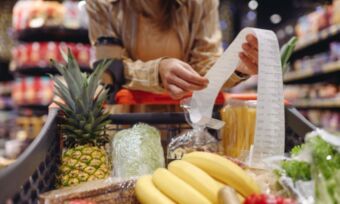7 simple swaps that could help you save $1,718 a year

Small changes can make a big difference to your hip pocket. Here are seven money-saving swaps that could potentially boost your savings.
When you are looking for ways to save extra money it’s common to think about what expenses you can cut out from your budget entirely. But that’s not the only way to go about it. There are a number of simple changes that you can make that could save you big bucks over the long term.
I have come up with a list of seven simple swaps that could potentially save you $1,718 a year. Keep in mind the figures are based on hypothetical scenarios (and the savings may be higher or lower for your situation) but it’s true what they say – the small things do add up.
1. Swap premium 98 or 95 petrol for 91
Filling up your tank can be an expensive exercise. The cut in the fuel excise announced in the 2022 federal Budget will bring some relief but it will only be temporary. For longer-term savings it may pay to think about what type of fuel you are using. The main options are 91, which is regular unleaded petrol, and 95 and 98, which are considered premium unleaded petrol. There can be a big price difference between the three, so if you are always filling up with 98 you may consider making the switch to 95 or 91.
Of course, before you do this, it’s important to check what your car manufacturer recommends you use. You can usually find this information on the fuel flap of your car. If it says “Premium unleaded only” then you shouldn’t use 91. If you are unsure you can always contact the manufacturer.
Canstar did some number crunching to show how much you could potentially save by swapping the type of petrol you use. This scenario is based on a 60-litre tank, refilled 20 times over the year ending January 2022. As you can see in the table below, switching from 98 to 91 could potentially save you more than $260 a year if you are in Queensland and close to $250 a year if you live in New South Wales. Even making the change from 98 to 95 could save you $87.42 in Queensland and $78.60 in New South Wales.
Potential saving: Up to $262.98 a year
Savings from swapping the type of unleaded petrol you use
← Mobile/tablet users, scroll sideways to view full table →
| QLD | NSW | |
|---|---|---|
| Average total cost of fuel over year to end of January 2022 | ||
| 91 (Standard Unleaded) | $1,843.20 | $1,790.76 |
| 95 (Premium Unleaded 95) | $2,018.76 | $1,960.56 |
| 90 (Premium Unleaded 98) | $2,106.18 | $2,039.16 |
| Savings from switching from… | ||
| 95 to 91 | $175.56 | $169.80 |
| 98 to 91 | $262.98 | $248.40 |
| 98 to 95 | $87.42 | $78.60 |
Source: www.canstar.com.au. Prepared on 29/03/2022. Based on fuel prices reported under the QLD Department of Energy & Public Works Fuel Price Reporting and NSW Department of Finance, Service & Innovation Fair Trading. Based on a passenger vehicle with a 60L petrol tank capacity that is refilled 20 times during the year starting on 1 February 2021. Number of refills based on the average rate of fuel consumption (11.1L/100km) and annual distance travelled (10,900km) by passenger vehicles in the 12 months ended 30 June 2020 from the ABS Survey of Motor Vehicle Use. Average cost based on the average fuel price in each state over 20 days during the year (corresponding with refilling the tank on 1 February 2021 and then every 19 days) applied to the 60L tank capacity.
→ Related: 8 fuel apps that can help you save money
2. Swap fresh milk for powdered milk
This swap is something that a lot of people may resist but substituting powdered milk for fresh milk is something you may want to try. If you don’t like the idea of drinking powdered milk then you may consider using powdered milk in other ways. For example, you can use powdered milk instead of fresh milk when you’re baking. In fact, some say that milk powder really enhances the flavour of baked treats such as cookies, brownies and cakes.
You can even use it to make fresh milk stretch further. The Joyful Frugalista, Serina Bird, offered this example: “When a two-litre bottle of milk is down to half, I make up a litre of powdered milk, pour it into the milk bottle, shake and store overnight. By the next morning, it tastes the same as fresh milk.”
A two-litre bottle of full cream milk costs $3.30 at my local supermarket. You can make two litres of milk using milk powder for $1.60. Assuming you swap two litres of fresh milk for powdered milk each week you could potentially save $88.40 over a year.
Potential saving: $88.40 a year
→ Related: 6 supermarket hacks that could save you money on groceries
3. Ditch the dryer and hang out your clothes
It can be so tempting to throw all your washing in the dryer but you can save money on electricity by hanging everything out to dry instead. Canstar did the sums and found that assuming you do six loads of washing each week, you could save $281 a year by hanging things on the line instead of popping them in the dryer (see table below).
Potential saving: $281 a year
Savings from hanging clothes out instead of using a dryer
← Mobile/tablet users, scroll sideways to view full table →
| Average annual energy consumption
(assuming 6 loads per week) |
1,158 kWh |
| Average electricity usage cost | 24.3 c/kWh |
| Annual cost | $281 |
Source: www.canstar.com.au – 29/03/2022. Average energy consumption figures based on 5-10kg condensor clothes dryers listed in the Commonwealth of Australia E3 Program’s Registration database. Average usage cost based on single-rate products on Canstar’s database, available for an annual usage of 4,200 kWh.
4. Pick up your takeaway instead of using a delivery service
More and more of us are using meal delivery services such as Uber Eats, Menulog, Deliveroo and DoorDash to get takeaway food delivered to our front door. Research from Roy Morgan showed that more than 5.5 million Australians aged 14 and over (26.5%) used meal delivery services in 2020, up from 3.9 million (19.0%) in 2019 and 3.3 million (16.3%) in 2018. The lockdowns no doubt contributed to that growth.
While using these services may be convenient, they aren’t necessarily great value. With Uber Eats, for example, you may be charged a delivery fee as well as a service fee which can quickly add up – in some cases this can be close to $10. On top of that, many restaurants charge higher prices through these apps to help recoup some of their costs for using these services. So, you might be able to purchase the same item cheaper if you ordered directly from the restaurant. One restaurant near me charges $17.90 for a whole charcoal chicken normally but $24.50 through Uber Eats.
Now, I could say you should ditch the takeaway altogether but I won’t go that far. One way to avoid these extra charges is to go pick up the food yourself. Let’s say you order takeaway once a week and save, on average, $10 a week by picking it up instead of using a meal delivery service – that adds up to $520 a year.
Potential saving: $520 a year
5. Swap name brands for generic brands at the supermarket
There’s no doubt that grocery bills account for a fair chunk of our household budgets. There are a number of ways you may be able to cut the costs and one worth considering is swapping brand name products for generic brands.
You don’t have to switch everything to generic. There may be some things you just really like the taste of and prefer not to compromise but with staples such as sugar, flour, tinned tomatoes and rice you may not even notice the difference. You can try out a few things and see how you go. Here are a few examples to give you an idea of the price differences.
White sugar (1kg)
Brand name: $1.95
Generic: $1.50
Flour (2kg)
Brand name: $5
Generic: $2.20
Tinned tomatoes (400gm)
Brand name: $1.40
Generic: $0.80
Long grain rice (1kg)
Brand name: $2
Generic: $1.40
Aussie households spend on average $153 per week on groceries, according to Canstar Blue. Let’s say, hypothetically, you save 2.5% on average a week by switching to some generic brand products. Over a year, you would have saved $198.90.
Potential saving: $198.90
6. Wash your clothes in cold water instead of warm
We are going back to the laundry now. This time it’s for you to think about using cold water when you pop a load of clothes in the washing machine rather than opting for a warm water cycle. Not only will this save you money but using cold water can help slow the fading of colours and help prevent fabrics from shrinking. If the items are very dirty or stained, though, it may be best to stick to warm water.
Canstar crunched the numbers and found that you could potentially save $67 a year by using a cold cycle instead of a warm one. This assumes you do seven loads a week (see table below).
Potential saving: $67 a year
Savings from using a cold wash cycle on a washing machine
← Mobile/tablet users, scroll sideways to view full table →
| Warm wash | Cold wash | Difference | |
|---|---|---|---|
| Average annual energy consumption
(assuming 7 loads per week) |
438 kWh | 159 kWh | 279 kWh |
| Average electricity usage cost | 24.3 c/kWh | 24.3 c/kWh | – |
| Annual cost | $106 | $39 | $67 |
Source: www.canstar.com.au – 29/03/2022. Average energy consumption figures based on 5-10kg washing machines listed in the Commonwealth of Australia E3 Program’s Registration database; only includes products that have both warm and cold wash cycle energy consumption data available. Average usage cost based on single-rate products on Canstar’s database, available for an annual usage of 4,200 kWh.
7. Hire clothes instead of buying a new outfit for a special occasion
Looking for a new outfit to wear to a wedding or a big night out? Instead of buying something new, which you will probably only wear once, it can be a good idea to rent it instead. It’s possible to hire a designer outfit for a fraction of the price it would set you back to buy it.
One site that lets you do this is GlamCorner. At the time of writing, you could rent a Zimmermann Lola Panelled Midi Dress, which retails for $750, for $149 or a Bec and Bridge Lady Lila Midi Dress, which retails for $240, for $69. Let’s assume that you do this for two events in a year and save $150 each time as a result, then over a year, you’d save $300.
Potential saving: $300 a year
Cover image source: Krakenimages.com/Shutterstock.com
This article was reviewed by our Editorial Campaigns Manager Maria Bekiaris before it was updated, as part of our fact-checking process.
- 1. Swap premium 98 or 95 petrol for 91
- 2. Swap fresh milk for powdered milk
- 3. Ditch the dryer and hang out your clothes
- 4. Pick up your takeaway instead of using a delivery service
- 5. Swap name brands for generic brands at the supermarket
- 6. Wash your clothes in cold water instead of warm
- 7. Hire clothes instead of buying a new outfit for a special occasion





